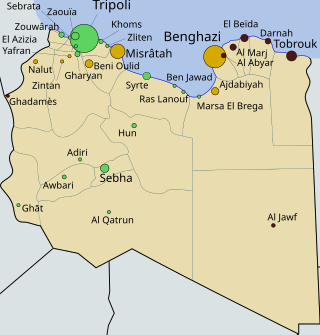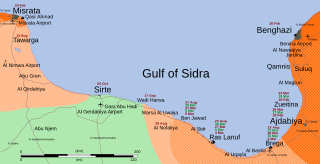Related Research Articles

Sirte, also spelled Sirt, Surt, Sert or Syrte, is a city in Libya. It is located south of the Gulf of Sirte, between Tripoli and Benghazi. It is famously known for its battles, ethnic groups, and loyalty to Muammar Gaddafi. Due to developments in the First Libyan Civil War, it was briefly the capital of Libya as Tripoli's successor after the Fall of Tripoli from 1 September to 20 October 2011. The settlement was established in the early 20th century by the Italians, at the site of a 19th-century fortress built by the Ottomans. It grew into a city after World War II.
Ras Lanuf is a Mediterranean town in northern Libya, on the Gulf of Sidra in Tripolitania. The town is also home to the Ra's Lanuf Refinery, completed in 1984, with a crude oil refining capacity of 220,000 bbl/d (35,000 m3/d). The oil refinery is operated by the Ra's Lanuf Oil & Gas Processing Company, a subsidiary of the state-owned National Oil Corporation. Additionally, the city houses the Ra's Lanuf petrochemical complex – a major oil terminal – and oil pipelines: the Amal–Ra's Lanuf, the Messla–Ra's Lanuf, and the Defa-Ra's Lanuf pipeline.
Bin Jawad District, was one of the districts (baladiyah) of Libya from 1983 to 1987. It lay in the northern part of the country bordering the Gulf of Sidra. Its capital was Bin Jawad. Under Italy it was in Misrata Province. Before being made a baladiyah in 1983, it was part of the governorate system. In 1987 the area was incorporated into Sirte District and has remained there since.

The First Battle of Brega was fought during the Libyan Civil War. It began when pro-Gaddafi government troops attacked the city, held by the National Transitional Council, in the early hours of 2 March 2011.
The Battle of Ras Lanuf was a two-phase battle in 2011 during the Libyan Civil War between forces loyal to Libyan leader Muammar Gaddafi and those loyal to the National Transitional Council. Both forces sought control of the town of Ras Lanuf. The first phase followed two days after the First Battle of Brega which occurred in the town Brega, roughly 130 kilometres (81 mi) to the east of Ras Lanuf. After conquering the town on 4 March, the rebels pushed further west to attack Sirte but they were driven back by government forces and on 11 March, government troops reconquered most of Ras Lanuf.
Bin Jawad, also known as Bin Jawwād, Bin Quwad is a town with estimated 8,488 inhabitants in the Sirte District in Libya. It is approximately halfway between Benghazi and Misrata. The nearest settlements are Nofaliya, which about 20 km to the west, and the port of Sidra, which is about 30 km to the southeast of Bin Jawad.
Nofaliya or Nawfaliya is a town in the desert in the Sirte District of Libya. It is west of Libya's major oil ports.
The Second Battle of Brega took place during the Libyan Civil War. More than 10 days earlier, anti-Gaddafi forces beat back an attempt by loyalist forces to take the town on 2 March 2011, in the First Battle of Brega. Following that battle, rebel forces advanced along the Libyan Coastal Highway, taking the towns of Ra's Lanuf and Bin Jawad. However, after the Battle of Bin Jawad and the Battle of Ra's Lanuf, government troops retook all of the territory lost and were once again threatening Brega by mid-March.

The First Gulf of Sidra offensive was the second major rebel offensive of the Libyan Civil War. It was mounted by anti-Gaddafi forces immediately after their victory in the Battle of Ajdabiya. The offensive was meant to have the rebel forces quickly reach Gaddafi's hometown of Sirte.
The Battle of Bin Jawad took place during the Libyan Civil War between forces loyal to Libyan leader Muammar Gaddafi and anti-Gaddafi forces for control of the town of Bin Jawad.
The Fourth Battle of Brega was a battle during the Libyan Civil War between forces loyal to Muammar Gaddafi and forces of the Libyan opposition for control of the strategic town of Brega and its oil port.
The Second Battle of Bin Jawad took place during the Libyan Civil War between forces loyal to former Libyan leader Muammar Gaddafi and those loyal to the National Transitional Council for control of the small town of Bin Jawad.

The Libyan Civil War began on 15 February 2011 as a chain of civil protests and later evolved into a widespread uprising against the regime of Muammar Gaddafi. On 25 February, most of eastern Libya was reported to be under the control of protesters and rebel forces. Gaddafi remained in control of the cities of Tripoli, Sirte and Sabha. By 15 March, however, Gaddafi's forces had retaken more than half a dozen lost cities. Except for most of Cyrenaica and a few Tripolitania cities the majority of cities had returned to Gaddafi government control.

The Second Gulf of Sidra offensive was a military operation in the First Libyan Civil War conducted by rebel anti-Gaddafi forces in August and September 2011 to take control of towns along the Gulf of Sidra in an effort to surround Muammar Gaddafi's hometown of Sirte, which was held by pro-Gaddafi forces. It ended on 20 October, with the capture and execution of Muammar Gaddafi and his son Mutassim Gaddafi, along with former defense minister Abu-Bakr Yunis Jabr. The Gaddafi loyalists in the area were finally defeated when NTC fighters captured Sirte.

The Shura Council of Benghazi Revolutionaries was a military coalition in Benghazi composed of Islamist and jihadist militias, including Ansar al-Sharia, Libya Shield 1, and several other groups.

The Islamic State (IS) had its core in Iraq and Syria from 2013 to 2017 and 2019 respectively, where the proto-state controlled significant swathes of urban, rural, and desert territory, mainly in the Mesopotamian region. Today the group controls scattered pockets of land in the area, as well as territory or insurgent cells in other areas, notably Afghanistan, West Africa, the Sahara, Somalia, Mozambique, and the Democratic Republic of the Congo. As of 2023, large swathes of Mali have fallen under IS control.
The Fall of Nofaliya refers to the takeover of the town of Nofaliya in Sirte District, Libya, by the self-declared Islamic State in February 2015.

The Battle of Sirte refers to the battle in the spring of 2015, in the region of Sirte, Libya, between the Islamic State of Iraq and the Levant (ISIL) and the Libya Shield Force. ISIL forces had been present in the city since February 2015, before the Fall of Nofaliya. After Nofaliya fell to ISIL forces, the Tripoli-based government had decided to send reinforcements to recapture Sirte.
The following lists events that happened during 2016 in Libya.

The Petroleum Facilities Guard is a Libyan oil company and militia led by Idris Bukhamada. Established in October 2012, it took control of the main oil export terminals in eastern Libya in the summer of 2013 and starting in March 2014 attempted to sell oil. In 2014, Ibrahim Jadhran ousted Idris Bukhamada, and became the new leader of the PFG. Despite initially allying himself with Khalifa Haftar, this alliance would later sour and lead to Jadhran accusing the LNA of trying to assassinate him in September 2015.
References
- ↑ Fadel, Leith (4 January 2016). "ISIS expands control over Libyan coast: Bin Jawad captured". Archived from the original on 5 March 2017. Retrieved 3 October 2016.